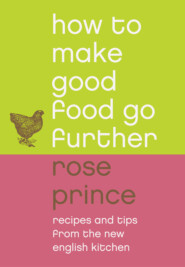По всем вопросам обращайтесь на: info@litportal.ru
(©) 2003-2024.
✖
The New English Kitchen: Changing the Way You Shop, Cook and Eat
Настройки чтения
Размер шрифта
Высота строк
Поля
When water comes into contact with flour, it swells the proteins in it. Kneading the dough by hand or machine allows these proteins to blend, changing the molecular structure and forming the all-important gluten.
You must choose if you want to add fat to your bread. Fat improves bread’s keeping qualities and gives it a denser texture. It can, however, prevent the dough becoming soft and elastic if it is rubbed into the flour before the water is added, because this delays the essential formation of gluten. Gluten is to dough what steel frames are to skyscraper construction. Its strength allows large spaces of air to form and hold within the dough. The best way to get bread going quickly is to add fat after the water. I do this by oiling the bowl that holds the dough as it rises, then mixing it in before the bread is shaped.
It is fine to leave fat out of bread; it simply results in a lighter dough with large bubbles. If you make small quantities of bread frequently, or rolls, there is no real need to add fat.
Two things kill yeast: too much salt, and heat. Don’t be too free with salt – follow the amount specified in recipes until you get to the stage where experience teaches you how much to add. And don’t leave the dough to rise anywhere too hot, such as on a radiator or beside a fire. In fact, bread doesn’t have to be left in a warm place to rise at all, and will even rise perfectly happily – though slowly – in the fridge. The important thing is that it should be in a draught-free place.
how to knead bread by hand
Take the dough, which will still be sticky, out of the bowl and place it on a floured work surface. Use both hands to pull and stretch the bread, folding it back on itself, pulling and stretching again, giving it a quarter turn each time. Persevere for several minutes – 15 is best. The process helps the gluten develop, making the dough silky, soft and elastic. Be robust when kneading – you can be as aggressive as you want, since it will speed up the process.
basic yeast bread
This recipe works well in a food mixer and can be used for the classic, rectangular tin loaf or for any other shape. Strong white flour, malted wheat, wholemeal or a mixture all work well.
Makes 2 small loaves
700g/1
/
lb flour
2 x 7g sachets of fast-action (easy-blend) yeast
1 heaped teaspoon fine salt or 2 teaspoons soft sea salt crystals
1 heaped teaspoon unrefined sugar
425ml/14fl oz water, at blood temperature
1 tablespoon vegetable or olive oil (optional – see here (#u48cba6ed-f130-4c25-8fcb-df01234d50f0))
Put the flour in a large bowl with the yeast, salt and sugar and stir until combined. Make a well in the centre and add the warm water, stirring all the time until the ingredients form a sticky dough. Continue to knead the bread – by hand (see above) for 15 minutes, or for 5 minutes on the slow setting of a food mixer fitted with a dough hook. If the dough is too sticky, add more flour; if it is too dry, work in a little water.
The dough will become smooth and elastic as the gluten forms. When you have finished kneading it, put it into an oiled bowl (if you are using the oil), cover with a cloth and leave in a warm, draught-free spot for 1 1/2–2 hours, until doubled in size (or leave for longer at cool room temperature, or overnight in the fridge).
Knock the air out of the dough, kneading the oil into it. Prepare two 480g/1lb loaf tins by brushing all over the inside surface with a little oil. Divide the dough in half, shape each piece into a fat sausage and put into a tin or make 2 rounds and place each in the centre of a baking sheet. Scatter flour on top, cut a slash lengthways down the centre with a sharp knife and leave to rise again, uncovered, for 20–30 minutes. Preheat the oven to 230°C/450°F/Gas Mark 8.
Bake the loaves for 30–40 minutes. They are ready when they come easily out of the tin and sound hollow when tapped on the base with a finger.
kitchen notes
To improve the quality of the crust, put a roasting tin half filled with water in the oven as you preheat it and leave in during baking.
If bread goes wrong, it could be the weather. Ambience affects bread: on humid days the dough needs slightly less water; when the weather is dry, it will need more.
You can freeze bread at almost any stage of the preparation – before the dough has risen; after knocking it back, or after baking.
more adventures with dough
Once you are hooked on making bread at home, it is easy to adjust the recipe or substitute different flours and ingredients. I am not crazy about adding olives, Parmesan, sun-dried tomatoes or fried onions to bread – I’d rather eat those things another way – but working fresh herbs or aromatics into the dough does have a good effect. A few chopped rosemary leaves or sage make a nice savoury bread. Steeping some saffron threads in the warm liquid before you add it to the flour makes a beautiful saffron-scented loaf, delicious with dry-cured meats and fresh cheeses.
To make tea bread, set aside a piece of dough and roll it into a rectangle. Scatter over a little brown sugar and some chopped dried fruit (figs, raisins, prunes or apricots), then roll it up into a Swiss roll shape. Either brush it with beaten egg and bake whole, or cut it into slices to make Chelsea buns, lay these on a greased baking sheet, brush with egg and bake. Scatter some golden caster sugar on Chelsea buns when they come out of the oven.
Substituting milk for water in your dough will make a softer, sweeter tea bread.
sourdough bread
Sourdough bread is a treat to buy from a specialist baker and can be eaten fresh or used in recipes. I admit I often beg mine from my sister and brother-in-law, Sam and Sam Clark. With apologies to the late M. Poîlaine, creator of the famous sourdough loaf, pain Poîlaine (see the Shopping Guide), and, honestly, no sibling conspiracy, I believe their experiments at their restaurant, Moro, have resulted in the absolute best there is. A recipe for it is given in Moro – The Cookbook (Ebury, 2001).
Slow fermentation of the yeast in bread makes a sour dough. You can make your own yeast, beginning with a combination of flour and fruit juice and ‘feeding’ the bacteria, but there are simpler methods for home kitchens. Leaving the dough to rise overnight in the fridge, rather than giving it a quick rise in a warm place, produces a more sour dough. You can also knead into it a piece of dough left over from breadmaking a few days earlier (keep it in the fridge, wrapped in cling film; it will sour as it matures). When you make your bread, use only half the yeast specified in the recipe and work the older dough into the new. Allow your dough to rise in the fridge either overnight or during the day. Once baked, the bread will have a full, ripe, savoury taste and the scent of toasted nuts. It will have a strong, tactile crumb, and larger bubbles even if you have used fat. There is no doubt at all that the inner crumb of sourdough keeps its elasticity longer. Nor will the flavour diminish as it ages: old sourdough bread will be as good eaten fresh as it is in your cooking.
soda bread
If you don’t have any yeast, or prefer not to eat it, soda bread is a wonderful quick standby and the best bread to eat, buttered, with smoked fish or pastrami. While yeast comes to life with the changing temperature and moisture in the dough, bicarbonate of soda reacts with sour milk or buttermilk, making bubbles that raise the dough and set when baked.
480g/1lb wholemeal flour (or a 50/50 mix of white and wholemeal
flour for a paler loaf)
1 teaspoon fine oatmeal
1
/
teaspoons fine salt
1
/
teaspoons bicarbonate of soda
30g/1oz butter
500ml/16fl oz sour milk (see Kitchen Note overleaf) or buttermilk
(or low-fat yoghurt)
Preheat the oven to 230°C/450°F/Gas Mark 8. In a large bowl, mix together the flour, oatmeal, salt and soda, then rub in the butter. Make a well in the centre and slowly add the liquid, mixing all the time. Work the flour in using your hand, until you have a soft but not sticky dough. Turn it out on to a board and shape lightly into a smooth round. Place on a greased baking sheet, scatter with a little extra flour and cut a deep cross on the top with a sharp knife. Bake for 30–35 minutes, turning down the heat to 200°C/400°F/Gas Mark 6 halfway through. The loaf is ready when the base sounds hollow when tapped with a finger. If the loaf is soggy underneath, bake it upside down for a further 5 minutes.
kitchen notes
To sour milk, warm it slightly, add about a teaspoon of lemon juice and leave to stand for a few minutes.
Soda bread makes good breadcrumbs but can be dry and rubbery when toasted, so it is best made frequently in small quantities.









